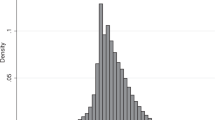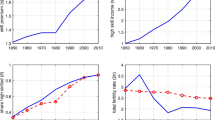Summary
This paper tests, within the framework of LISREL, the causal structures of occupational status, earnings, and fertility expectations using data from the 1984 Canadian Fertility Survey of currently married and common-law women aged 18–44. Differential occupational status, earnings, and fertility among three groups of wives classified by generation of Canadian residence are also examined. The models incorporate age, education, work experience, and ethnic/English language ability as exogenous determinants of occupational status, earnings, and fertility.
The major findings are: (1) lower earnings of third generation wives are strongly related to lower levels of education, work experience, and job status; (2) wives who speak an ethnic language are likely to have lower fertility than comparable wives who do not speak an ethnic language; and (3) generational effects on earnings and fertility are limited to differences in education, work experience, and occupational status.
Similar content being viewed by others
References
Balakrishnan, T.R., Karol J. Krotki, and Evelyne Lapierre-Adamcyk (1985), ‘Contraceptive Use in Canada, 1984,’Family Planning Perspectives, 17, pp. 209–215.
Bean, Frank D. and John P. Marcum (1978), ‘Differential Fertility and the Minority Group Status Hypothesis: An Assessment and Review,’ in: Frank D. Bean and W. Parker Frisbie (eds.),The Demography of Racial and Ethnic Groups, New York, pp. 189–211.
Bean, Frank D. and C. Gray Swicegood (1982), ‘Generation, Female Education, and Mexican American Fertility,’Social Science Quarterly, 63, pp. 131–144.
Bean, Frank D., Ruth M. Cullen, Elizabeth H. Stephen, and C. Gray Swicegood (1984), ‘Generational Differences in Fertility among Mexican Americans: Implications for Assessing the Effects of Immigration,’Social Science Quarterly, 65(2), pp. 572–582.
Beaujot, Roderic P., Karol J. Krotki, and P. Krishnan (1977), ‘Analysis of Ethnic Fertility Differentials through the Consideration of Assimilation,’ Paper Presented at the Annual Meetings of the Population Association of America, St. Louis.
Blake, Judith (1968), ‘Are Babies Consumer Durables?,’Population Studies, 22, pp. 5–25.
Blishen, Bernard R. and Hugh A. McRoberts (1976), ‘A Revised Socioeconomic Index for Occupations in Canada,’Canadian Review of Sociology and Anthropology, 13(February), pp. 71–79.
Boyd, Monica (1979), ‘Immigrants, Income Attainments, and Labour Markets in Canada,’ Paper Presented at the 1979 Annual Meeting of the Population Association of America, Philadelphia, Pennsylvania.
Cain, Glen G. (1966),Married Women in the Labour Force: An Economic Analysis, Chicago.
Cain, Glen G. and Adriana Weininger (1973), ‘Economic Determinants of Fertility: Results from Cross-Sectional Aggregate Data,’Demography 10, pp. 205–223.
Easterlin, Richard A. (1969), ‘Toward a Socio-economic Theory of Fertility,’ in: S.J. Behrmanet al. (eds.),Fertility and Family Planning. A World View, Ann Arbor, pp. 127–156.
Featherman, David L. and Robert M. Hauser (1978),Opportunity and Change, New York.
Fischer, Nancy A. and John P. Marcum (1984), ‘Ethnic Integration, Socio-economic Status, and Fertility among Mexican Americans,’Social Science Quarterly, 65, pp. 583–593.
Gould, W., W. McManus and F. Welch (1982), ‘Hispanic Earnings Differentials: The Role of English Proficiency,’ Report Sponsored by the National Commission for Employment Policy.
Johnson, Nan E. (1979), ‘Minority Group Status and the Fertility of Black Americans 1970: A New Look,’American Journal of Sociology, 84, pp. 1386–1400.
Joreskog, K.G. (1973), ‘A General Method of Estimating a Linear Equation System,’ in: A.S. Goldberger and O.D. Duncan (eds.),Structural Equation Models in the Social Sciences, New York, pp. 85–112.
Joreskog, K.G. (1977), ‘Structural Equation Models in the Social Sciences: Specification, Estimation, and Testing,’ in: P.R. Krishnaiah (ed.),Applications of Statistics, Amsterdam, pp. 265–287.
Joreskog, K.G: and D. Sorbom (1978),LISREL IV: Analysis of Linear Structural Relations by the Method of Maximum Likelihood, Chicago.
Joreskog, K.G. and D. Sorbom (1982), ‘Recent Developments in Structural Equation Modelling,’Journal of Marketing Research, 19, pp. 404–416.
Joreskog, K.G. and D. Sorbom (1986),LISREL VI: Analysis of Linear Structural Relationships by Maximum Likelihood, Instrumental Variables, and Least Square Methods, Mooresville, Indiana.
Ladewig, Becky H. and Gail W. McGee (1986), ‘Occupational Commitment, a Supportive Family Environment, and Marital Adjustment: Development and Estimation of a Model,’Journal of Marriage and Family, 48, pp. 821–829.
McLaughlin, Steven D. (1983), ‘English Language Proficiency and the Earnings of MexicanAmerican Men,’ Paper Presented at the 1983 Annual Meetings of the Population Association of America, Pittsburg, Pennsylvania.
Mincer, Jacob (1962), ‘Labor Force Participation of Married Women,’ in: H.G. Lewis (ed.),Aspects of Labor Economics, Princeton, N.J., pp. 63-97.
Mincer, Jacob (1974),Schooling, Experience, and Earnings, New York.
Oppenheimer, Valerie K. (1972), ‘Rising Educational Attainment, Declining Fertility, and the Inadeqanceies of the Female Labor Market,’ in: Charles F. Westoff and R. Parke, Jr. (eds.),Demographic and Social Aspects of Population Growth, The Commission of Population Growth and the American Future, Research Reports, Vol. 1. Washington, D.C., pp. 305–328.
Roberts, Robert E. and Eun Sul Lee (1974), ‘Minority Group Status and Fertility Revisited,’American Journal of Sociology, 80, pp. 503–523.
Rosenwaike, Ira (1973), ‘Two Generations of Italians in America: Their Fertility Experience,’International Migration Review, 7, pp. 271–280.
Smith, Stanley K. (1981), ‘Determinants of Female Labour Force Participation and Family Size in Mexico City,’Economic Development and Cultural Change, 30, pp. 129–152.
St. John, Craig and Harold Grasmick (1983), ‘Racial Differences in the Fertility Process: An Elaboration of the Minority-Group Status Hypothesis,’ Paper Presented at the Annual Meetings of the Population Association of America, Pittsburg, Pennsylvania.
Tremblay, V. and G. Trudel (1984),Canadian Fertility Survey: Methodological Report, Montreal, PQ., Centre de Sondage, Université de Montreal.
Uhlenberg, Peter R. (1973), ‘Fertility Patterns with the Mexican American Population,’Social Biology, 20, pp. 30–39.
Verdugo, Naomi T. and Richard R. Verdugo (1984), ‘Earnings Differentials Among Mexican American, Black, and White Male Workers,’Social Science Quarterly, 65, pp. 416–425.
Waite, Linda J. (1980), ‘Working Wives and the Family Life Cycle,’American Journal of Sociology, 86, pp. 272–294.
Westoff, C.F., R.G. Potter, P.C. Sagi, and E.G. Mishler (1961),Family Growth in Metropolitan America, Princeton.
Author information
Authors and Affiliations
Additional information
The author is grateful to Dr. Karol J. Krotki, co-director of the Canadian Fertility Study, for permission to analyze the Canadian Fertility Survey data. Special thanks are also due to Ms. Margaret King for her comments on an earlier draft of the paper.
Rights and permissions
About this article
Cite this article
Krishnan, V. Occupational status, earnings, and fertility expectations: Development and estimation of a causal model. De Economist 136, 358–382 (1988). https://doi.org/10.1007/BF01151809
Issue Date:
DOI: https://doi.org/10.1007/BF01151809




